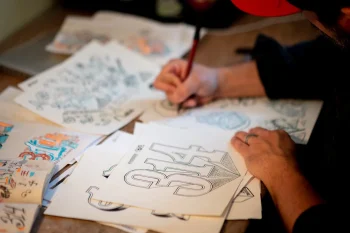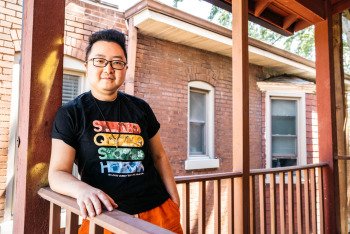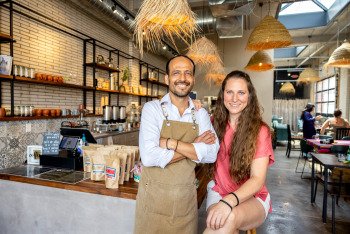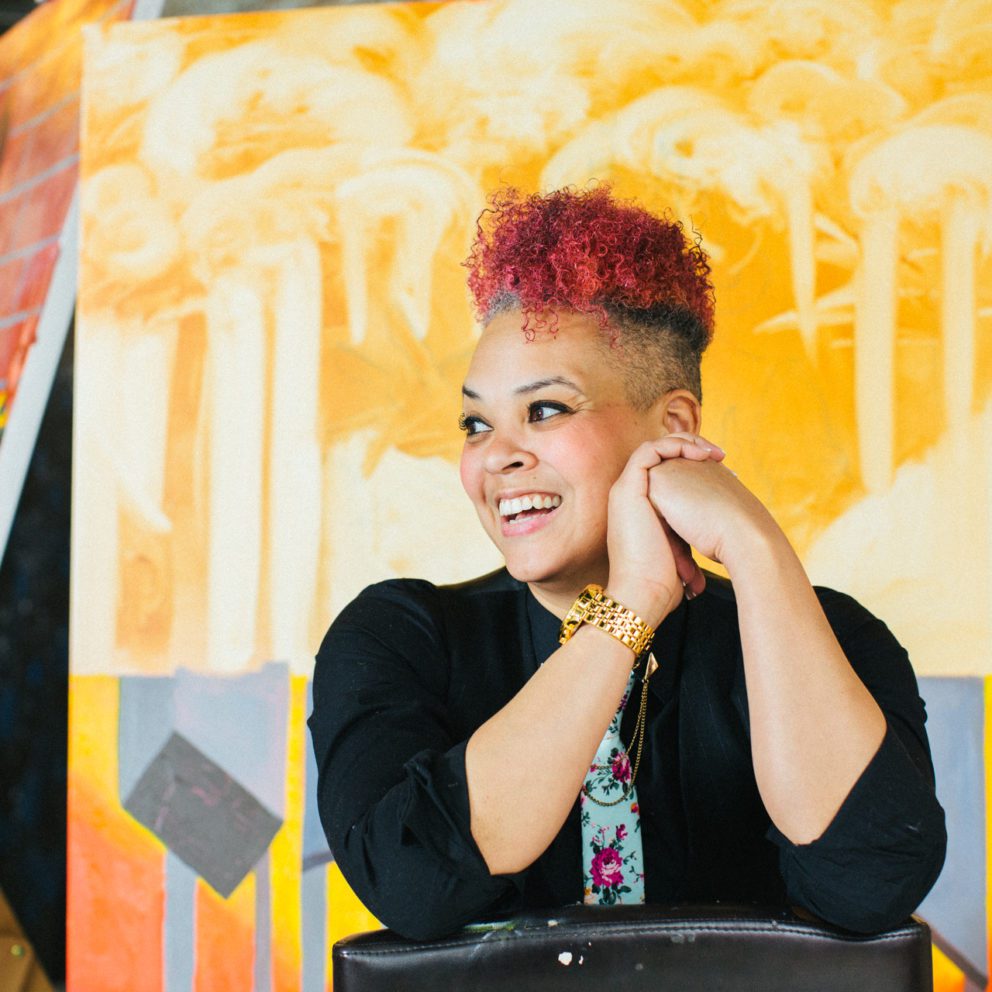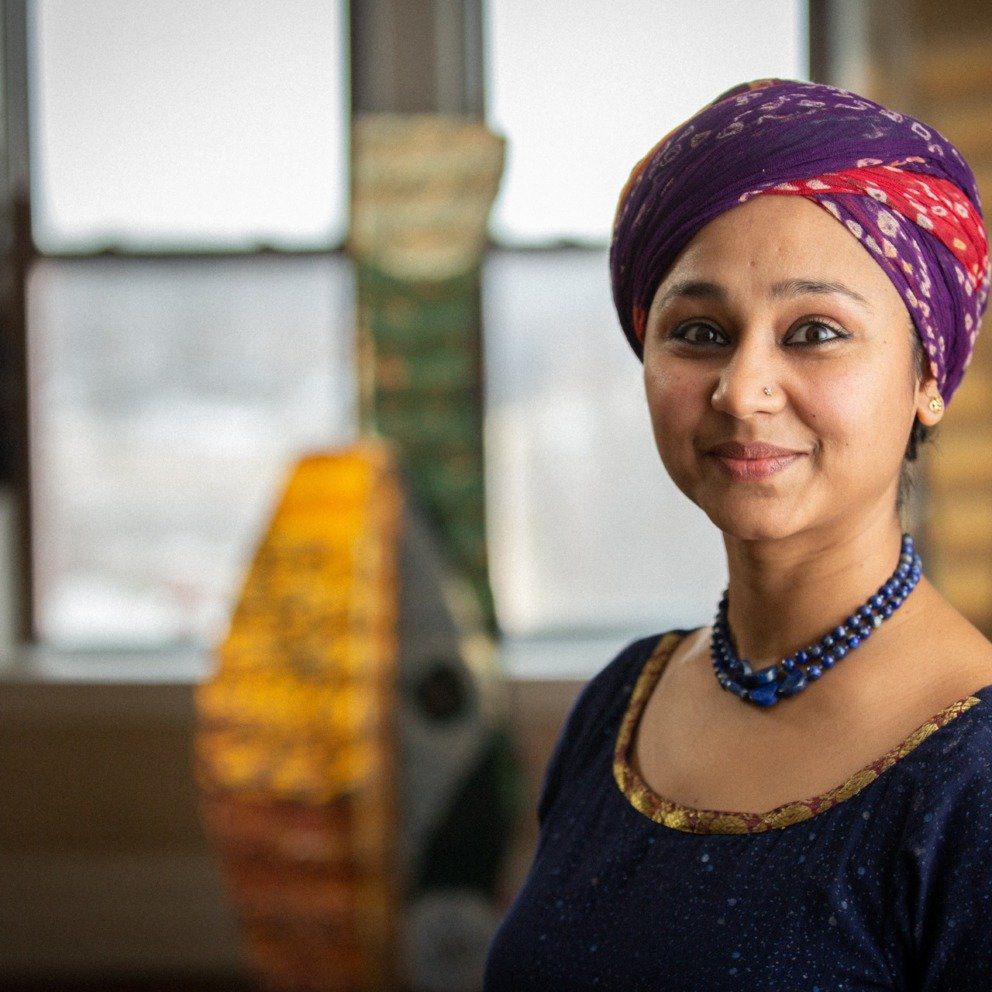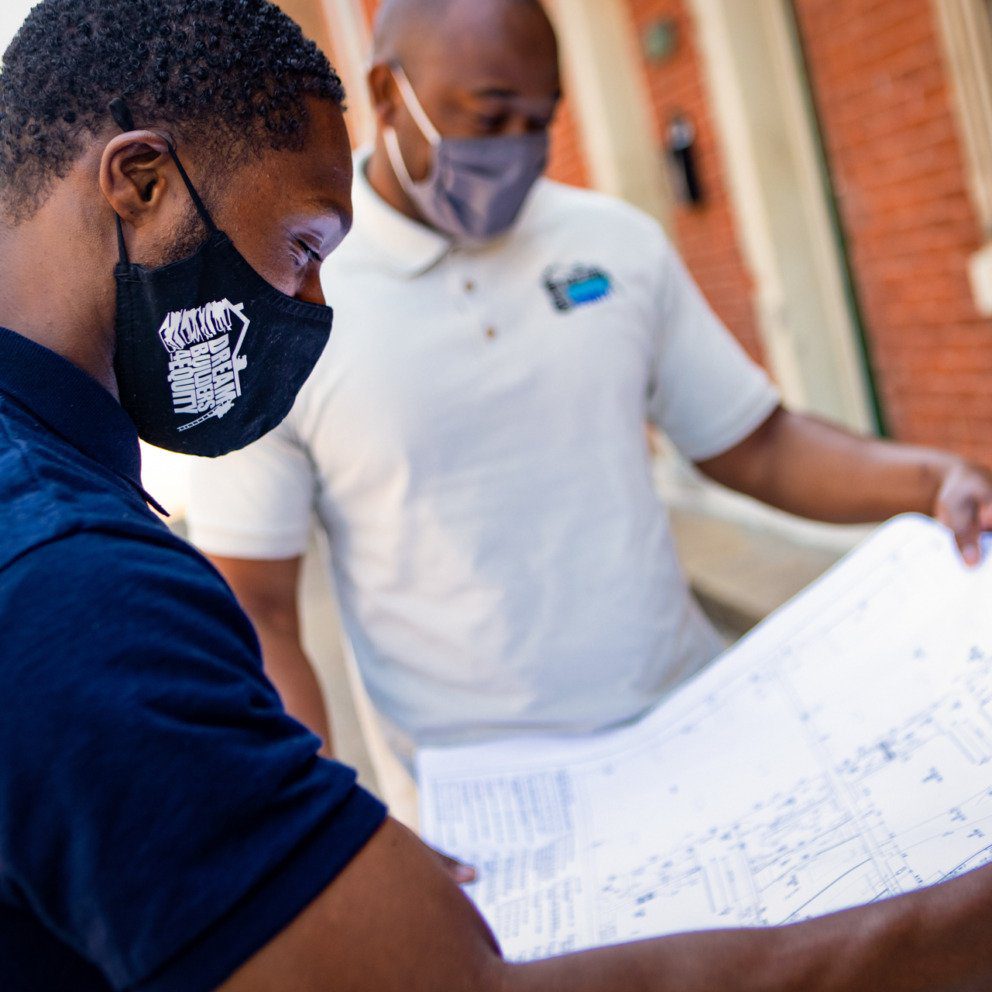A Home for Art
In Gravois Park, St. Louis Art Place Initiative has completed the first of 20 units of single family housing at subsidized prices for artists, aiming to enrich the community and support artists in the region.
A two-story brick home in Gravois Park, built in 1897, has been taken down to the studs and completely, beautifully restored, ready to be a blank canvas for the artist who will move into it. Construction is underway on other homes for artists nearby, all of which will be subsidized to be affordable on an artist’s income. Renovating vacant houses and building new homes adds value to the neighborhood; filling those homes with artists positively impacts the community; and home ownership offers stability and equity for the artists who will live in Art Place.
That’s the vision of the St. Louis Art Place Initiative, founded by Kranzberg Arts Foundation, Incarnate Word Foundation and the Regional Arts Commission to build up the Gravois Park neighborhood while providing a pathway for artists to home ownership. It’s a one-of-a-kind organization that brings together several groups that all share a passion for moving the city forward and recognize the importance of artists’ contribution to the region.
“We believe that arts are the heart and soul of our city,” says Chris Hansen, executive director of Kranzberg Arts Foundation. “They’re not an amenity. They’re an essential part of our economy, and they’re an essential part of our existence as humans.”
Five years ago at a planning meeting for the Gravois-Jefferson historic neighborhoods, residents voiced concerns that with housing prices in the area increasing, low to moderate income artists were being displaced and forced to move out of the community. Once that need was voiced, several organizations came together to discuss not only how to provide a solution, but how to go even further and help artists build wealth through equity. The initiative partnered with Dutchtown South Community Corporation, Habitat for Humanity St. Louis, Dream Builders 4 Equity, St. Louis Development Corporation, city of St. Louis Community Development Administration, as well as artists and Gravois Park residents, to develop the goal of building 20 units of single family housing for sale to artists at subsidized prices.
“When we started with Art Place, we had a commitment to do a large degree of community outreach to help design this program in a way that was responsive to the needs of the neighborhood,” says Kaveh Razani, director of operations for the initiative.
“Part of that process was having a town hall and engagement events with different artists that have been historically community-connected. And those artists helped us understand what the traditional barriers have been to home ownership, and helped us design an application for housing that made sense according to needs and desires and hurdles they faced.”
Artist and Gravois Park resident Pacia Anderson heard about the plans to develop housing for artists and was initially skeptical, although she is intimately familiar with the challenges artists face in trying to buy a home. “A lot of times artists, especially in St. Louis, work in the gig economy,” says Anderson. “A lot of the documentation that is necessary, a lot of the requirements that are necessary for traditional home mortgages are just really difficult, they’re really hard barriers for artists to overcome. This gives a less intensive opportunity for an artist and their family to own a home in what I think is a really beautiful neighborhood.”
She acknowledges that the area has difficulties, too.
“Gravois Park has many challenges with vacancies, with crime, with divestment, and with, quite frankly, private developers coming and seeing it as an opportunity for land grab,” says Anderson. “I realized, if this could be a way that we can help stabilize the neighborhood as far as the housing goes, help provide artists the opportunity to own their own homes and have equity and build generational wealth, then maybe this is something that I could be interested in. So I did some more research, and ended up joining the board.”
Anderson serves on the St. Louis Art Place Initiative board as a representative of both the neighborhood and of artists and the vitally important role they play in the region.
“I think in every aspect of St. Louis city and county and metro region, artists are embedded,” says Anderson. “If we’re talking about politics, artists are elected officials from committee people all the way up. When you talk about police reform or any type of movement involving public safety, artists are there. When you’re talking about entrepreneurship, when you’re talking about all the organizations that help with the unhoused, every single area I can think of, numerous artists were involved in those movements and making the community better.”
Hansen agrees that artists are key not just in creating art, but in their contributions as active citizens of the St. Louis community.
“I look at art like air and water,” Hansen says. “To take art away is something that we couldn’t live without. The arts also lead us through change. It leads us through very difficult conversations. I think the arts have led in a lot of St. Louis’ work around anti-racist practices, inclusivity and diversity… the arts tell us about our history, they tell the stories of our communities, they give voice and platforms to marginalized individuals and communities.”
While artists’ contributions are beneficial to the neighborhood they reside in, owning a home can also benefit artists and the work they produce.
“These homes provide an opportunity for an artist to set down roots in a way that’s stabilizing for their practice,” says Razani. “I know that it can be very frustrating to have to move every couple years, to deconstruct a studio that is very specific to a space, to try to peel all the layers of paint they’ve put on a wall before the next person has to move in. It can be very challenging to have a consistent art practice when you don’t know if you’ll have a space renewed when your lease is up.”
One of his hopes for the initiative is that it provides a foundation and stability for artists to be able to do what they do best: create.
“A big part of me really feels like our future homeowners will have the opportunity to really dig into their careers as artists, because they have these homes to build off of,” says Razani. “And I’m a firm believer in home ownership as a tool for generational wealth.”
Stan Chisholm was the first artist to take residence in an Art Place home, and even before the landscaping was completed, he had already painted most of the walls inside and made it his own. As both a musical and visual artist, a teacher at a nearby school and someone who grew up in the neighborhood, Razani says Chisholm was exceptionally suited to be the first candidate approved for an Art Place residence. While his home is the first to be completed, just across the street, renovations are well underway on the second house and plans are in progress for three new builds a little further down the block. The initiative plans to develop the housing units in a range of sizes to suit a variety of artists’ needs, ranging from one to four bedrooms, and from gut renovations of century-old homes to new builds on vacant lots. It’s an ambitious goal.
“The organizations that founded Art Place are no strangers to this type of development and construction. I think if a different organization was looking at some of the homes that we’ve chosen to rehab, they’d think we were crazy, attempting to do the work that we’re doing,” says Razani. “But given that we’re bringing arts, philanthropy and fair housing together in this project, we found that folks have been very eager to support the work that we’re doing. So we are able to be very comprehensive in how we’re rehabbing the buildings that already exist, and how to think critically about building new housing stock that’s not going to start to deteriorate in 10 or 20 years. They’ll be homes that last for generations.”
The community partners that St. Louis Art Place Initiative chose to collaborate with have been key in getting their lofty goals off the ground.
“In our endeavor to see who offered best-in-class and affordable housing construction, we connected immediately with Habitat for Humanity St. Louis,” says Razani. “They were our first choice as a project partner because of their legacy of building homes for low to moderate income clients in the city and their track record of building homes that last and for having a very, very low foreclosure rate for their clients. So we felt like what they already knew was exactly what we needed to learn.”
This is the first time that Habitat for Humanity St. Louis has partnered with another group in this manner, and it’s a shift in focus for them. The organization typically builds new housing stock, but the first two homes for the initiative are gut rehab projects. The collaboration with Habitat is just one example of the ways that St. Louis Art Place Initiative differs from other real estate development projects.
“This is very unique,” Hansen says. “We’ve taken some different models and we’ve put them together. We’ve brought the arts funding and arts infrastructure development, arts-based community development hat into affordable housing,” says Hansen. “We’ve done deep community work and included all the stakeholders that already had a voice in that process. We work with partners like Dream Builders 4 Equity, Habitat for Humanity St. Louis and Grice Architecture, to really help us envision how to do it. And we built an amazing application process with a strong emphasis on diversity in our homeowners.”
They’ve brought listening and engagement to every step of the process, including tackling the reality that being approved for even an affordable mortgage may be the biggest hurdle for an artist.
“We built pipelines direct to banks so that these artists actually could build a relationship with a bank,” Hansen says. “Artists are going to be able to enter into a home with a thousand dollars down at a 2.5 percent interest rate for a 30-year fixed mortgage for a home that otherwise they wouldn’t be able to afford and didn’t have the credit worthiness to be approved for, because most artists are self-employed, they don’t show well on the books and banks have a hard time lending to them.”
The initiative has also taken steps to ensure that these homes stay affordable for artists long term, instead of being flipped for a profit.
“We’ve built these mechanisms to ensure not only do they have the direct relationships, but we’ve also ensured that the community governs the process,” says Hansen. “We’ve built land use restrictions that ensure that a house always has to stay affordable for an artist. We’ve also given public space back to a community land trust, which is governed by the neighborhood, to ensure that a community can come around and activate it and program it and imagine its future in that footprint.”
As a Gravois Park resident, Anderson is especially excited by that prospect.
“After a certain amount of time and the houses are built and occupied, there’s the opportunity for the organization to create a community land trust so that after that the houses are owned by the artists, but there is an organization that ensures that they don’t fall into disarray,” says Anderson. “If someone wants to sell their house, that they can still get their equity out of it, but not flip it and raise property values and do the complete opposite of what the project wanted in the beginning, which is stabilize the neighborhood.”
Ultimately, the future of Art Place will be the responsibility of its residents and neighbors.
“I like that even though there’s this coalition of these people with all this experience and all these connections, they understand this isn’t a thing that I’m going to do and I’m just going to sit on this board forever,” she says. “There is a handoff, where we’re getting this thing started and then the community is going to carry it on through the years.”
While Anderson hopes that the Gravois Park community will continue what the initiative has started, she also would love to see it continue on beyond the neighborhood and have a ripple effect on other communities around it.
“I’m hoping that with Art Place, we have people who love St. Louis, people who are interested in being solid and stable in one place, adding to the beauty of the community and the people there,” Anderson says, “and that it spreads and germinates out, not just in Gravois Park, but in other neighborhoods.”
Hansen, too, feels that the arts can be a boon for the region, and that projects like St. Louis Art Place Initiative have the potential to help lift up an industry that was deeply impacted by the events of March 2020 and what followed.
“I truly believe that if the city would recognize that the arts are one of the top five things to sell in this city, there’s no other place in the nation that has the type of rich cultural density, affordability, infrastructure in the way that it has, and then also a legacy and a history that can’t be denied,” says Hansen. “I think the arts are a massive part of us rebounding, and the more we can do to support the arts right now, the more the arts will be able to do to support us.”
As for how it feels to hand over the keys to a home for an artist to make their own, Razani says: “Knowing some of Stan’s personal journey and how much commitment he has to his arts practice — seeing someone rewarded for hard work when the system isn’t set up to reward his work because of the nature of his occupation and profession… it’s been magical.”
Join the Story
- Learn more about St. Louis Art Place Initiative.
- Check out our three-part series on one of the initiative’s collaborators, Dream Builders 4 Equity.
- Volunteer with Habitat for Humanity.
